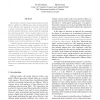Free Online Productivity Tools
i2Speak
i2Symbol
i2OCR
iTex2Img
iWeb2Print
iWeb2Shot
i2Type
iPdf2Split
iPdf2Merge
i2Bopomofo
i2Arabic
i2Style
i2Image
i2PDF
iLatex2Rtf
Sci2ools
CVPR
2005
IEEE
2005
IEEE
Space-Time Behavior Based Correlation
We introduce a behavior-based similarity measure which tells us whether two different space-time intensity patterns of two different video segments could have resulted from a similar underlying motion field. This is done directly from the intensity information, without explicitly computing the underlying motions. Such a measure allows us to detect similarity between video segments of differently dressed people performing the same type of activity. It requires no foreground/background segmentation, no prior learning of activities, and no motion estimation or tracking. Using this behavior-based similarity measure, we extend the notion of 2-dimensional image correlation into the 3dimensional space-time volume, thus allowing to correlate dynamic behaviors and actions. Small space-time video segments (small video clips) are "correlated" against entire video sequences in all three dimensions (x,y, and t). Peak correlation values correspond to video locations with similar dynamic b...
3dimensional Space-time Volume | Behavior-based Similarity Measure | Computer Vision | CVPR 2005 | Entire Video Sequences | Similar Dynamic Behaviors | Space-time Video Segments |
| Added | 12 Oct 2009 |
| Updated | 12 Oct 2009 |
| Type | Conference |
| Year | 2005 |
| Where | CVPR |
| Authors | Eli Shechtman, Michal Irani |
Comments (0)

